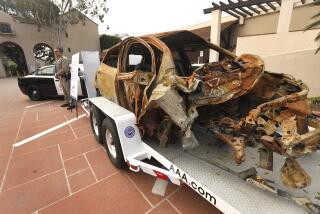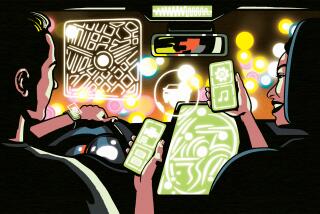Drivers Dialing for Danger With Cellular Phones
- Share via
Talking on a cellular telephone while driving quadruples the risk of having an accident, making it as dangerous as driving while drunk, Canadian scientists report today.
The first large study of the wireless phones, which now number 34 million in the United States, also found to the authors’ surprise that so-called hands-free phones are no safer than conventional hand-held phones.
“This may indicate that the main factor . . . is a driver’s limitations in attention rather than dexterity,” said Dr. Donald A. Redelmeier of the University of Toronto.
But the good news, he added, is that if you do have an accident, the cellular phone makes it much easier to get help.
Surprisingly, the authors of the report, which appears today in the New England Journal of Medicine, are not recommending bans on using the phones while driving.
“Our study is not about the role of regulation, but about the role of individual responsibility,” Redelmeier said. “Our role is to inform the debate [over cellular phone safety], not to dominate the discussion.”
An editorial in the same journal by Dr. Malcolm Maclure of the Harvard School of Public Health and Dr. Murray Mittelman of Beth Israel Deaconess Medical Center in Boston said that the research is “the first direct evidence that the use of cellular telephones in cars contributes to roadway collisions.”
“No insurance company would be surprised by [the findings],” said Steven Goldstein, director of public relations for the Insurance Information Institute, which represents several large insurance companies. “Hand-held [cellular phones] should not be used while you are driving any more than you should turn around while you are on the interstate to reprimand your child in the back seat,” he said.
A spokesman for the Cellular Telecommunications Industry Assn. cautioned, however, that the study showed only that there is an association between talking on the phone and accidents, not that talking on the phone actually causes accidents. But even the industry group cautioned against using the phones while driving.
“When you are behind the wheel, your most important responsibility is safe driving. Period,” said the association’s Tim Ayers. “It is not using a phone, or drinking coffee, or reading a map or combing your hair.”
Redelmeier and statistician Robert J. Tibshirani studied 699 accidents in Toronto over a 14-month period in 1994 and 1995. None of the accidents involved serious injuries. In each case, they used telephone company records to determine whether the driver was using a cellular phone during or immediately before the accident.
For controls, they used the same drivers, examining their phone records from the day preceding the accident. This type of “crossover study” is the scientific way of asking: “Did anything unusual happen to you immediately before the event being studied?”--in this case, the collision.
Overall, they found that people using a cellular phone were 4.3 times as likely to have an accident as other drivers. Those using hands-free phones were 5.9 times as likely to have an accident, but the number of such drivers was too small for the difference between accident rates using hands-free and hand-held phones to be statistically significant. They did not examine other potential causes of inattention.
For comparison, Redelmeier noted that driving with a blood-alcohol level at the legal limit also causes a fourfold increase in risk. But a blood-alcohol level 50% above the legal limit gives a tenfold increase.
The use of phones while driving has been controversial since they were introduced. Both simulations and real driving experiments have shown that such calls slow reaction times by half a second or more.
Placing a call was found to be no more distracting than tuning a car radio or engaging in an intense conversation, early studies found, but it made steering more imprecise--doubling the amplitude of steering wheel movements--especially in city traffic.
The only previous study of a link between cellular phones and accidents was reported last March by epidemiologists John M. Violanti of the Rochester Institute of Technology in New York and James R. Marshall, now at the University of Arizona. They mailed a survey to 60 of 100 drivers who had collisions in New York state and to a control group of 77 randomly selected drivers.
They concluded that drivers who spent more than 50 minutes per month on their cellular telephones had a fivefold increase in risk. In comparison, they also concluded that taking one or both hands off the wheel produced a threefold increase in risk, while lighting cigarettes or drinking beverages produced a twofold increase. Other activities, such as smoking, talking with other people or watching scenery had a much smaller risk.
That study was largely dismissed because of the small number of participants. Today’s findings, however, seem to confirm its conclusions.
“I think it is consistent with what we found,” Violanti said. “All the results are trending in the same direction.”
As a result of the earlier studies, Brazil, Israel, Switzerland and two states in Australia have banned the use of hand-held phones while driving. Some other countries, such as Germany, are considering such action.
But few in this country are arguing for such a law. “I frankly don’t think it would be enforceable,” Violanti said.
The insurance industry also doesn’t support a ban. “What we support is responsible driving,” Goldstein said. Cellular phones “serve an important purpose,” he added. “If they are used for safety, they can make the difference between life and death.” An estimated 18 million emergency and 911 calls are made from cellular phones each year in the United States.
How to be safe? Virtually everyone agrees: Avoid unnecessary calls, keep conversations short, pull over when you are talking, and hang up when driving conditions become hazardous.
(BEGIN TEXT OF INFOBOX / INFOGRAPHIC)
Risk Factors
Driving while using a cell phone carries about the same risk as driving while drunk, according to a study of 700 accidents published in the New England Journal of Medicine.
Normal driving risk (baseline risk is one accident in every 100,000 trips)
Drinking beverages while driving: 200% increase
Lighting a cigarette while driving: 200% increase
Talking on cell phone while driving: 400% increase
Driving with blood alcohol at legal limit: 400% increase
Driving with blood alcohol 50% above legal limit: 1,000% increase
Sources: Various studies, including University of Toronto report published in New England Journal of Medicine






